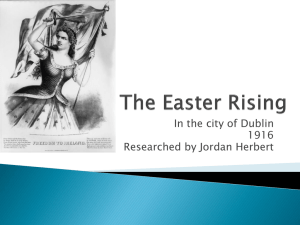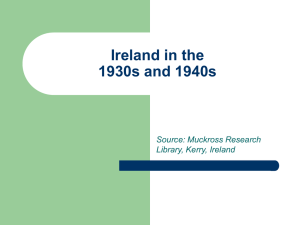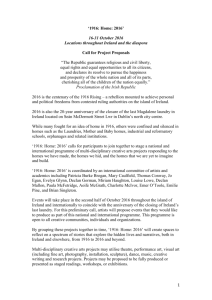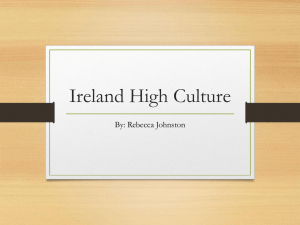Transcription Feedback Form: Hand-out 2
advertisement
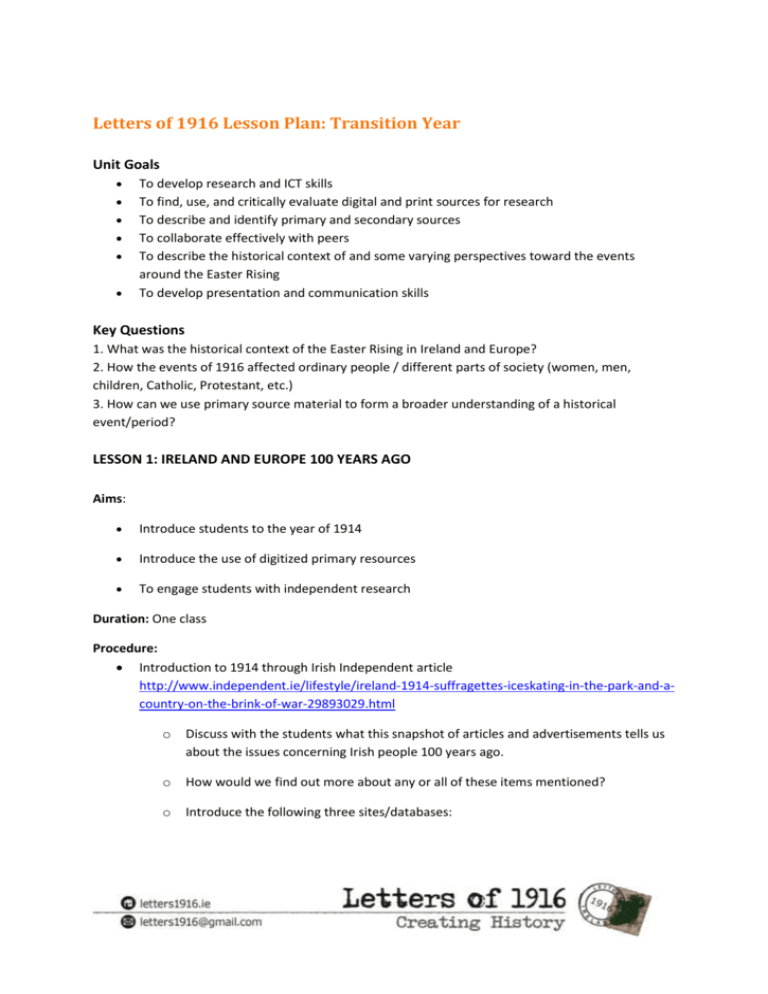
Letters of 1916 Lesson Plan: Transition Year Unit Goals To develop research and ICT skills To find, use, and critically evaluate digital and print sources for research To describe and identify primary and secondary sources To collaborate effectively with peers To describe the historical context of and some varying perspectives toward the events around the Easter Rising To develop presentation and communication skills Key Questions 1. What was the historical context of the Easter Rising in Ireland and Europe? 2. How the events of 1916 affected ordinary people / different parts of society (women, men, children, Catholic, Protestant, etc.) 3. How can we use primary source material to form a broader understanding of a historical event/period? LESSON 1: IRELAND AND EUROPE 100 YEARS AGO Aims: Introduce students to the year of 1914 Introduce the use of digitized primary resources To engage students with independent research Duration: One class Procedure: Introduction to 1914 through Irish Independent article http://www.independent.ie/lifestyle/ireland-1914-suffragettes-iceskating-in-the-park-and-acountry-on-the-brink-of-war-29893029.html o Discuss with the students what this snapshot of articles and advertisements tells us about the issues concerning Irish people 100 years ago. o How would we find out more about any or all of these items mentioned? o Introduce the following three sites/databases: http://www.rte.ie/centuryireland/ as a digital resource. Discussion about available material. http://www.irishtimes.com/archive http://archive.irishnewsarchive.com/Olive/APA/INArch.Edu/Default.aspx Divide the 47 items between the students or select one per student. Certain items should be selected to help with context later on i.e. Home Rule, Irish Volunteers etc. Ask the students to research their item on either/both of the above databases or anywhere else. In some cases they should aim to find the exact article or advertisement referenced, in others they may find a reference to the movement/organisation from any time throughout the year. Sometimes using a general search engine may be the simplest way to get directed to the item. Students should report back to the class Questions after feedback o What appear to be the main concerns of Irish people in early 1914? o What is the Lockout about? o Is there evidence of poverty in Dublin being an issue? o What evidence is there that poverty is not a concern for everybody? o In item 13, what “war” is referenced here? o Why do you think there is no mention of this elsewhere on the sheet? o What is the Home Rule Movement about? o Are there any alternative views on Irish Nationalism? o Are there people opposed to Irish Nationalism? o What is the Irish Volunteer Movement? Introduction to Ireland and Europe 1914-1916 (Power-point) Q1. What was going on in Ireland in 1914? Q2. What was going on in Europe in 1914? LESSON 2: DIGITAL RESOURCES Online connection: required / optional Handouts: X printed articles from the Irish Times –Teacher’s choice of articles Aims: Provide an overview of digital resources. Which sources are more reliable, useful? What kind of information they provide? An introduction to more research tools and independent research Duration: One class Procedure: Introduction to: Culture Ireland http://www.rte.ie/centuryireland/ Census of Ireland 1901/1911 http://www.census.nationalarchives.ie/ Students pick/are given an article from the Irish Time from 1914 and research the topic in X groups of X. LESSON 3/4: SOURCES AND RESOURCES: INTRODUCTION TO LETTERS 1916 Aims: To introduce students to the different digital repositories, archives and online research resources To introduce the students to the letters 1916 project and concept of crowdsourcing To engage the students interest by allowing them to participate/ transcribe Duration: One double class if timetable and schedule permits Required resources: Computer lab and internet connection Hand-out 1: research resources Transcribing instructions (Letters of 1916: Getting Started PDF and Transcribe a Letter PDF) Hand-out 2:Transcribing feedback Procedure: The students will have engaged in research (based on the newspaper articles) in the early classes. They should have recorded the sources of their information. Based on the students’ experience, the teacher chairs a short class discussion on the different types of sources and how to locate them on-line The teacher distributes hand-out 1 with the various online resources, briefly describes the nature of each, and explains that they will be useful later in the module. The teacher introduces the Letters 1916 project using the Letters of 1916 PowerPoint and emphasises the participative nature of the project – shared input into archiving history, and the democratisation of history. The teacher distributes the hand-out with instructions about transcribing. Each student will navigate the site to find a letter on a theme or topic that interests them. Using the instructions provided, the students will contribute to the project by transcribing their own letters. If unfinished the students will finish the transcription at home, and fill in a general feedback form hand-out 2 LESSON 5/6: GETTING TO KNOW THE WRITER Aims: To familiarise the students with the 1916 letters as primary source material To apply the early lessons on the contextualisation and guided research skills to researching a specific personality. Duration: 1-2 class periods depending on individual teacher’s schedule. Required resources: Approximately 20 letters provided by the Letters 1916 project. Letters from the perspective of a volunteer/family member Letters from the perspective of a British soldier/ family member/government officials Letters from women A list of online resources / archives to guide research (provided by the teacher in the previous class) Worksheet 3 with uploading metadata subject fields/biography. Description: In the previous classes, the teacher will have introduced the students to research skills and the broad context of 1916. The students are organised into pairs. Each pair of students will be asked to choose a letter at random. The writer of the chosen letter will be that pair’s chosen personality for the rest of the module. Using the Think, Pair, Share, methodology, the students will read the letter individually, and answer the following questions. 1. What is the writer’s name? 2. To whom is the person writing? 3. When was the letter written? 4. What do you think is the writer’s primary concern/ motivation for writing? 5. What do you think is the value of using letters like these to access/understand the period more fully? 6. Are there any problems with using letters to understand what happened in the past? The students will then share their ideas with their partner, and look for similarities or differences in their ideas. The teacher will then invite feedback from the class, about the last two questions in particular, encouraging debate on the possibilities and problems of the primary sources. For homework (or in class, if time and facilities allow) the students will be asked to conduct research on their chosen person to expand on their first impressions. (worksheet 3) The individual pairs gain an expert knowledge, and take an ownership of their chosen personality. They will bring this knowledge with them when they are assigned to a larger group for the final project. Prior to the project beginning students can be put into their groups of 6 (3 pairs) and introduce each other to their personalities and share the results of their research. Students can be tasked with finding similarities/differences among the contents of the letters, as initial points of comparison. This activity can serve as a jumping off point for student- generated research, or students can be assigned a topic by the teacher for the final research project. LESSON: FINAL PROJECT, A “DOCUMENTARY” Overview: The pairs of students will be combined into larger groups of 6 (3 pairs) and will work together to ultimately create a documentary-style final product to present their understanding of a specific topic related (teacher-assigned or student selected) to the 1916 Easter Rising, World War I or wider social issues. Duration: Students will need several class periods and/or days at home to complete the final project. However, it is easily possible to extend or shorten the project requirements and expectations, making this a 2-3 class period assignment, with some work at home. Required resources: Computers and internet access to conduct further research If available: video recording device and video editing software (iMovie) Computer and projector to show clips of historical documentaries (several are available, especially on this topic, at http://www.rte.ie/worldwar1) If technology is not available, students can present their documentaries in class in a more traditional interview format Handout 4: Documentary handout with assignment directions Procedure: Locate a few documentaries (probably just short video clips) that you believe are done well and can serve as good models for your student. http://www.rte.ie/worldwar1 has some good options. Introduce students to the concept and purpose of documentaries as a means of telling history and show a few of your pre-selected documentaries, identifying important elements such as the narrative and interviews Explain to students they will be creating a documentary to present their understanding of the time period, specific events, people they've researched, and the multiplicity of ideas toward various topics of this time Students should be out into groups of 6 (3 groups of two). Depending on your individual goals, it could be beneficial to group them by a specific topic or type of person (i.e. group them by 'home rule' or 'women'). Read through the assignment directions and expectations with your students Before beginning the assignment, students must sign up for individual roles (also explained in detail on the project directions in handout 4) Post-project discussion questions: o How did you decide which information to include in the narrative script and which information to have the personalities speak? o How did the 1916 letters help you develop a personality and voice for the characters? o What were some of the challenges in creating this project? How did you overcome them? o How did you decide where/when to set your documentary? Why did the people in the film dress the way they did? o Which sources were most beneficial/user-friendly for the different elements of the project? Why? o What were some benefits and challenges of working with partners and with a group? Free Online Databases/Resources: Hand-out 1 1901/1911 Census (http://www.census.nationalarchives.ie/search/) The 1901 and 1911 censuses are the only surviving full censuses of Ireland open to the public. The 1901 census was taken on 31st March 1901. The 1911 census was taken on 2 April 1911. This search engine allows you to search for people living in Ireland on these specific dates. The return forms provide information regarding name, age, residence, gender, occupation, religion and literacy. Family Search (https://familysearch.org/search) Family Search allows you to look for someone through based on certain criteria ranging from name and residence to birth or death records. Their records span across hundreds of collections including birth, marriage, death, probate, land and military. Manuscript Collection Lists (http://www.nli.ie/en/ManuscriptListResult.aspx) The Manuscript Collection Lists provide detailed listings of the contents of manuscript collections held in the National Library of Ireland. Each catalogue begins with a brief biography relating to the subject of the papers. The Diary of Mary Martin (http://dh.tcd.ie/martindiary/) A Family at War: Mary Martin’s Diary, 1 January – 25 May 1916 is an online exhibition of the Diary of Mary Martin, a widow and mother of twelve children, living in the affluent Dublin suburb of Monkstown. Soldiers’ Wills (http://soldierswills.nationalarchives.ie) The National Archives of Ireland holds a collection of the wills of Irish soldiers who died while serving in the British Army. Most of these date from World War I but there is a small number from the late 19th Century and from the period of the South African War, 1899-1902. The documents have been digitised by the National Archives and are now available free online. Bureau of Military History (http://www.bureauofmilitaryhistory.ie/) This collection is a joint initiative of the Military Archives and the National Archives which allows you to search for the Bureau of Military History free of charge. Their records include 36,000 pages of witness statements, an index of witnesses, press cuttings from 1916 and an image gallery with audio recordings. United Kingdom Census (http://www.ukcensusonline.com/index.php) On this website, you will find some practical information about the UK census and how to use it to research your family history, including full name, exact age, relationship to head of household, sex, occupation, parish and county of birth, medical disabilities and employment status. Basic information is free for further information a subscription fee is required. Alternative site that contains the same information (http://www.1911census.co.uk/search/tnaform.aspx) Irish Geneology (http://www.irishgenealogy.ie/en/) This website holds a large searchable volume of pre 20th Century Church records of Baptism, Marriage and Burial that in many instances pre-date the Civil Registration. Commonwealth War Graves Commission (http://www.cwgc.org/) We commemorate the 1,700,000 men and women of the Commonwealth forces who died in the two world wars. Our cemeteries, burial plots and memorials are a lasting tribute to those who died in some 153 countries across the world. Our Register records details of Commonwealth war dead so that graves or names on memorials can be located. Google (https://www.google.ie/) Sometimes google can lead you to obscure websites, such as google books, wikipedia and the Australian Dictionary of Biography, which can contain relevant information so it’s usually worth a try. Google is also useful for figuring out obscure names by typing in different options and seeing if any seemingly accurate results come up, or for trying out different spellings of places to figure out an address. Try using Advanced search operators and search operators British Pathé (http://www.britishpathe.com/) This isn’t really a database for research for specific people but provides additional information as to contemporary viewpoints through interviews and videos. Transcription Feedback Form: Hand-out 2 Name: _____________________________ Who was the writer of your chosen letter and to whom was he/she writing? Writer: ______________________________________________________ Recipient _____________________________________________________ Explain briefly why you chose to transcribe this particular letter? __________________________________________________________________________________ __________________________________________________________________________________ __________________________________________________________________________________ __________________________________________________________________________________ __________________________________________________________________________________ Why was this letter written? __________________________________________________________________________________ __________________________________________________________________________________ __________________________________________________________________________________ __________________________________________________________________________________ Did you find anything in the content of the letter surprising or interesting? __________________________________________________________________________________ __________________________________________________________________________________ __________________________________________________________________________________ __________________________________________________________________________________ __________________________________________________________________________________ What, in your opinion is the benefit of having access to a site like “Letters of 1916”? __________________________________________________________________________________ __________________________________________________________________________________ __________________________________________________________________________________ __________________________________________________________________________________ __________________________________________________________________________________ Biography: Hand-out 3 Now that you have been introduced to your personality, you must engage in research to create a fuller picture of who he/she was. Using the resources provided, try to answer the questions below. A) Writer’s name: _________________________________________ B) Recipient’s name: ________________________________________ C) Date that the letter was written: _______________________ D) In the space below, provide a description of the contents of the letter (what is he/she writing about). A summary of the main details. E) Date of birth and death of the writer. _______________________ F) Date of birth and date of the recipient. ______________________ G) In the space below provide any other information that you have discovered about the writer: (e.g their family, work, politics, publications, achievements, life after 1916) Final Project: 1916 Documentary: Hand-out 4 Name: _____________________________________ Project Due Date: ____________________________ Overview: Following the style of the various documentaries we watched and evaluated together in class, you will work in your groups of 6 to create a 4-5 minute video documentary presenting your understanding of _______________________. Collectively, you will script, act, direct, video, and edit what will become a masterpiece film! Project Criteria and Scoring Guide Excellent Good Needs Improvement Below Expectations Narrative Script Acting/Authentic Voice Demonstration of understanding of topic/event/people Overall Video, Production and Editing Collaboration/ Group Work Bibliography/ sources used Student Roles: Before embarking on this group project, you will decide amongst yourselves which role each group member will take. You will sign off that you understand and commit to completing the expectations of each role, and you will be held accountable for carrying out those duties. Role Project Director and Coordinator The overall project manager keeps the group focused and on task. S/he provides written feedback, outlining the groups progress and/or challenges, to the teacher on at least 3 occasions prior to the due date. S/he also guides the group in the writing, directing, costuming, setting, and acting - essentially the production of the documentary. Narrator/Head Script Writer The narrator is primarily responsible for writing and editing the contributions of others to the script of the documentary. S/he will also play the part of the narrator/interviewer in the documentary. The narrator must be audio, but may also be video (it’s your stylistic choice) Videographer/Film Editor The videographer and editor is in charge of the filming and editing of the the project. S/he is responsible for creating a smooth, edited film, as well as choosing editing techniques (such as special effects and music) to enhance the overall production. Actors There will be 3 actors in each group, representing the 3 people you’ve researched. It is the job of the actor to take ownership of presenting this personality either by playing the part of that person or by acting as a historical, expert scholar on this person. Working in conjunction with the script writer, it is the responsibility of the actors to develop the language and responses of their personality to questions posed during the interviews. Student Signature

